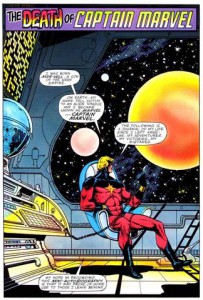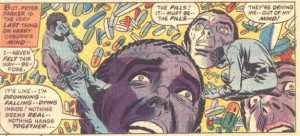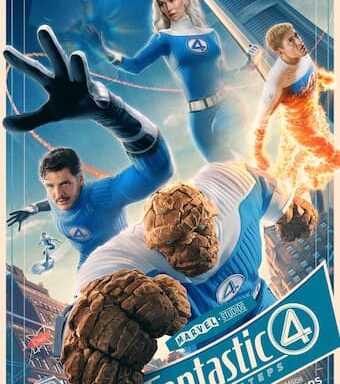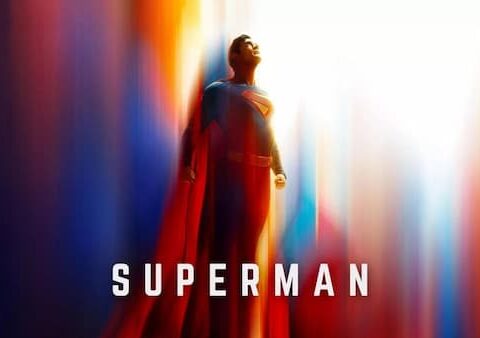In honour of the new Ms Marvel title and its completely unnecessary ‘backlash’, here are 5 other ‘talking-point’ milestones in Marvel Comics’ history, selected after some contemplative beard-stroking…
Marvel Comics over the years haven’t been strangers to ‘controversy’. For every misguided person objecting to a Muslim teenager inhabiting the ‘Ms Marvel’ mantle, there have previously been objections to characters being revealed as gay or even to black characters, among other things.
But here I’ve picked out 5 specific examples of ‘controversial’ moments in Marvel’s print history. And none of them are about race or colour, thankfully.
The Rape of Ms Marvel (Avengers #200, October 1980)
It may in fact be the most controversial, talked about moment in Marvel’s history. In Avengers #200, Ms. Marvel is abducted, subjected to mind altering drugs, has sex while in this essentially date-rape condition, and eventually gives birth to the S.O.B who abused her.
She then went off with the same man who did this to her and – this is the aspect that has probably troubled the most people over the years – ‘Earth’s Mightiest Heroes’ the Avengers make practically nothing of it and simply let her go off as if it had been nothing more than a little roll in the hay. Meanwhile the Marcus character responsible for her treatment isn’t even really regarded as a wrongdoer.
Comic book historian Carol A. Strickland criticized the storyline at the time in a famous essay titled “The Rape of Ms. Marvel” (it is never referred to or acknowledged as ‘rape’ in the comic itself).
The great Chris Claremont also commented on the inappropriateness of the storyline and was effectively compelled to undo much of it himself as soon as he could in Avengers Annual #10.

Here was an extraordinary example of some woefully inept writers not even realising they were doing anything controversial and in the process creating one of the most undeliberately offensive comic books of all time.
Yet Avengers #200 managed to get passed America’s famous Comics Code Authority created to monitor comic-book material aimed at children (and passed Marvel’s chief editors too, for that matter).
In essence, a leading Marvel heroine – and one designed to be something of a feminist icon, no less – is brainwashed into sexual submission, forced to give birth, and then shown to be emotionally attached to the perpetrator after the act, enough so for her to go off with him, all while her friends do nothing to intervene or to question the nature of what has transpired.
Claremont, thank heavens, managed to restore some of Ms Marvel’s dignity the next year with the help of Professor Xavier and the X-Men, who help Carol Danvers to restore her proper mind and her memories. The Avengers, in their lowest moment, come to try to take Danvers back into their fold, but Carol rightly assails them for their indifference towards her rape and for allowing Marcus to have taken her away after what he’d done to her.
Yes, there’s been some pretty awful characterisation in comic books over the years, but the way the ‘heroic’ Avengers, Iron Man, Captain America and all, were portrayed in this instance has to be down there among the very worst.
The storyline is felt to have badly damaged Ms Marvel’s standing as a character, and in fact it wasn’t only until relatively recently that the character started to regain some caliber in the Marvel Universe and is in fact now at the height of her popularity.
But when you think about how long the character was in the wilderness for, it’s something of a blessing that we have her back, stronger than ever. She could’ve easily remained lost to the black-hole of comic-book infamy.
The Death Of Captain Marvel (1982)
As in the original Captain Marvel, whose cosmic hero title now belongs fittingly to former Ms Marvel, Carol Danvers.
Marvel’s first graphic novel is universally regarded as a Jim Starlin masterpiece. This was a watershed moment for Marvel and for mainstream comic-books; the death of the powerful cosmic hero MarVell from cancer.

The expiring hero is surrounded on his deathbed by friends, loved ones, fellow super heroes and Marvel characters, all come to pay their respect to their departing contemporary; what feels like most of the Marvel Universe shows up, not just the poster boys but everyone from Archangel and Colossus to Vision and Starfox to Black Panther and Black Widow.
Even that perennial cosmic mega-villain, Thanos, shows up; but not to cause trouble – rather he arrives to guide the dying MarVell into the afterlife.
The graphic novel, now a bona fide classic, is a must-read for any Marvel fan. The fact that such a character dies not in some epic showdown, but from a slow, debilitating, and all-too-painfully human illness is what made the story so shocking, particularly for its time; though I suspect the shock value would apply even if it happened today. Part of the book is also retrospective, with some of Marvel’s more cerebral characters like T’Challa (Black Panther) and Reed Richards desperately trying to find a cure for the cancer; but of course they fail, and the original Captain Marvel faces his mortality, all his super powers and cosmic heroism unable to undo the terminal.
There’s something particularly bleak about seeing all these superheroes and powerful beings surrounding him, yet none of them are able to use any of their powers to save this one life and curtail this inevitable death.
The mainstream comic-book world is notoriously unrealistic when it comes to characters’ deaths; as in no one ever really dies for good – everyone from Magneto and Magik to Superman has ‘died’ at some point. But Captain Marvel was one instance where death was death; Starlin’s masterstroke wouldn’t retain its power and poignancy all these many years later if it hadn‘t been final.
“Green Goblin Reborn!” (The Amazing Spider-Man #96-98, May–July 1971)
Written by Stan Lee, though actually at the request of the Nixon administration’s Health, Education and Welfare Department, this famous 1971 Marvel story arc is recognized as the first mainstream comic to portray (albeit only to condemn) drug abuse, credited with leading to a revision of the Comics Code Authority’s inflexibility.

The Comics Code Authority in fact refused to approve the story even though it had a clearly anti-drugs theme, but Marvel went ahead and published the issues without the Authority’s approval.
Curiously, at around the same time DC Comics published a two-issue Green Lantern story in which Green Arrow’s ward, Speedy, begins using heroin. Now if only there was a pro-drugs story somewhere just to balance out the equation; though, come to think of it, I’ve always assumed Doctor Strange was smoking some potent shit and we were just never shown it.
And Moondragon is definitely on something.
Death of Illyana Rasputin (Uncanny X-Men #303, 1993)
This is one that resonates for me, because I distinctly remember reading it when I was about 13 and at that time a dedicated X-Men comics reader (I was doing the whole lot, everything from X-Force to Uncanny).
It features the death of the character Illyana Rasputin, former New Mutant and sister of the X-Man Colossus. At the time, being young, it was one of the most moving things I’d yet read in my life, as Illyana is one of the first mutants to fall victim to the Legacy Virus, which was at the time seen by many as an allegory for AIDS, in keeping with a prevailing view that the Mutant world in X-Men was in part allegorical to the experiences of the gay community in the preceding decades.

Poignant, even difficult to re-read for that reason, at the time of it’s publication in 1993 Illyana/Magik fans campaigned to prevent the release of the storyline, but it went ahead (and so it should – no writer or creative artist should ever bow to outside pressure).
The genius of the issue is that the grief is expressed primarily through the lens of another young character, Jubilee: so that it becomes a very strong, focused character piece handled deftly by Scott Lobdell.
The fact that immediately following this issue in Uncanny X-Men #304 we have the dramatic return of Magneto (at Magik’s funeral) and the onset of an epic X-Men story event just demonstrates how superb and how well paced the series was at the time.
But, at any rate, it was a bold direction for the writers to go in: and it really resonated.
Northstar’s ‘Coming Out’ (Alpha Flight #106, 1992)
In 1992 Alpha Flight’s Northstar became the first openly gay character in Marvel comics. In fact, the character was intended to be gay long before that, but both the Comics Code Authority and Marvel’s editor-in-chief Jim Shooter had a policy against openly homosexual characters, and so the writers were limited to only being able to ‘imply’ Northstar’s gay orientation despite knowing themselves that he was definitely gay.
When Scott Lobdell had Northstar openly declare his sexual orientation in 1992, Alpha Flight #106 sold out in a single week even though it wasn’t a popular title, and the mainstream press gave the subject considerable attention.
Curiously, however, very little mention was made about Northstar’s sexuality beyond #106; between then and the end of the Alpha Flight series in 1994 one exception was a story in which Northstar’s sister Aurora, while suffering a split personality, rejects his homosexuality with one side of her personality (though accepts it with the other).
A subsequent Northstar mini-series completely whitewashed the matter, ignoring his sexual orientation. By the time Northstar was brought back from obscurity in the early 2000s he was far less reticent about expressing his sexual orientation, as writers were able to get more with the times; in effect, however, he was now too flirty, even allegedly getting jiggy with Hercules, though Iceman didn’t requite Northstar’s affections.
The culmination of this particular character’s personal journey occurred in 2012 with Astonishing X-Men #51 and Northstar’s marriage to his civilian boyfriend Kyle; Marvel’s first same-sex marriage. I actually haven’t read this. Also I’ve never found Northstar very interesting and I have no idea who Kyle is. But opinion on the writers’ handling of this wedding ‘event’ appears broadly favourable, with the characterisation judged to be even-handed, including disapproval of the union from Warbird. What I have seen of it seems vaguely reminiscent of the wedding of Jean Grey and Scott Summers in X-Men #30 in 1994.
Whether or this story was timed to coincide with DC‘s ‘outing’ of the old Green Lantern, it was certainly timed to coincide with Gay Pride Month that year.
Not as controversial in 2012 as it might’ve been years ago, but a laudable milestone; even if it’s for a couple of rather dull characters.
____________________
By now, there are probably more such examples to be cited: with more to come. Comic books, like any other medium, will always have the capacity to cause ‘controversy’ or strong reactions – especially when writers are doing their job right.
____________________
Read more: ‘About the BATGIRL Cover Controversy‘, ‘No, CAPTAIN AMERICA ISN’T an Anti-Semite‘…





Mumra, I’d recommend giving the new Ms Marvel title a try. But I’d also recommend starting the current ‘Captain Marvel’ series from #1 and giving that a go. You don’t need to know the whole history of the character – you can pick up on that as you go along (or, shit, just Wikipedia it).
I commented on an earlier post about my lack of knowledge of Ms Marvel. Should I skip reading this and get straight on that reboot train? I’m someone who tries to avoid all spoilers if possible. Thanks.
I agree with you. I’ve never felt Northstar was particularly interesting anyway; but I think different writers were never fully clear on what to do with him or what he was about. There have been a lot of characters like that; characters who’ve never really found a solid identity.
I remember the early issues of Alpha Flight portraying Northstar as a womanizer. Never could understand
the reverse in the character’s personality, did the writer’s chalk that up as cover-up? They could have created a whole new character rather than change the personality of an existing one. Point is people don’t go from one extreme to the other. Unless they want to say like his sister he had multiple personalities also.